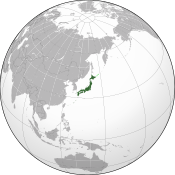Japan suggests dumping Fukushima waste at sea as radiation hits lethal levels
Monday, September 2, 2013
Radiation at Japan's damaged Fukushima Nuclear Power Plant yesterday spiked to lethal levels around a leaking tank. Today the national Nuclear Regulation Authority (NRA) said contaminated water may be pumped into the sea.
Tanks holding contaminated water at the site continue to leak; operator Tokyo Electric Power Company (TEPCO) says up to 300 metric tons may have leaked from one tank alone. Radiation at that tank soared to 1,800 millisieverts per hour yesterday, a rate lethal to an exposed human in about four hours. Japanese law says nuclear workers cannot be exposed to more than 50 millisieverts in a year.

Image: Sodacan.
TEPCO says other locations at the plant have readings of 70–230 millisieverts per hour. Waste water totalling more than 300,000 tons has already been collected at the site; more is being stored at a rate of 400 tons per day. An unknown quantity of radioactive groundwater is flowing into the sea.
NRA boss Shinichi Tanaka told a press conference today that stored water may be pumped into the Pacific after treatment to reduce contamination to within legal limits. "I'm afraid that it is unavoidable to dump or release the water into the sea," he said, adding "careless management" was being applied to the water by TEPCO.
| The situation at Fukushima is changing everyday... The accident has yet to be settled down. | ||
—Shinichi Tanaka | ||
TEPCO first noticed a leak at the now-deadly tank in July but said it was minor and the NRA gave it a level one "anomaly" rating on the seven-part international scale. Last week that was raised to "serious incident", level three, after TEPCO said up to 300 tons of water had leaked. The exact amount is unknown as there is no gauge to measure levels inside the tank and TEPCO staff had said water levels in the tank had remained constant.
Last week levels under the tank, where lost water is thought to have seeped into the ground, stood at 100 millisieverts per hour, and another at the facility had a level of 70 millisieverts per hour. TEPCO found another leak yesterday in a pipe between coolant tanks. Highly radioactive material was dripping out, but TEPCO says the leak is now fixed. Monitoring at the site has been increased since the original leak's discovery two weeks ago.
Around 1,000 tanks are used to store water from the power plant's coolant system, which was contaminated when three reactors melted down after a tsunami in March 2011. Around 160,000 people were evacuated in the worst nuclear disaster since 1986. Tanaka said "The situation at Fukushima is changing everyday... The accident has yet to be settled down."
The new radiation involves beta rays, TEPCO said, which can be stopped with a sheet of metal. Water treatment has extracted caesium from the tanks but other radioactive elements remain. TEPCO's equipment to remove other contamination is out of action due to filter corrosion after a few months of operating, but the government has demanded it be returned to service this month.
None of the tanks have monitoring equipment and TEPCO's initial procedure involved two employees manually checking each tank over a two-hour period. Since the tank was found to be leaking the total monitoring staff has increased from ten to 60, and patrols are carried out four times a day instead of twice a day.
Prosecutors brought criminal charges against TEPCO and government officials including then-Prime Minister Naoto Kan for their handling of the crisis formed after the tsunami. Daily newspaper Sankei Shimbun today claimed all charges, brought after local residents complained, were to be dropped. Sankei Shimbun suggests a formal announcement may come within days.
Kansai Electric Power today began shutting down one of only two reactors still generating power in Japan, reactor #3 at Oi Nuclear Power Plant, for mandatory inspection. The other, Oi's reactor #4, is to be permanently switched off this month. When the accident began nuclear energy supplied a third of Japan's power requirements, but in the aftermath of Fukushima the nation has switched to fossil fuels.
Related news
- "Estimated 300-ton radioactive leak at Fukushima rated 'serious incident' by watchdog" — Wikinews, August 29, 2013
Sources
- Reuters. "Radiation levels at Japan's Fukushima nuclear plant spike" — CBC News, September 2, 2013
- Mark Willacy and wire agencies. "Radioactive water from the Fukushima nuclear plant to be dumped into Pacific" — ABC News (Australia), September 2, 2013
- Mari Yamaguchi, The Associated Press. "More tank leaks found at Fukushima nuclear plant" — CTV News, September 2, 2013
- Jacob Adelman, Yuriy Humber, Takashi Hirokawa. "Japan’s Nuclear Watchdog Sees Ocean Dump for Fukushima Water" — Bloomberg News, September 2, 2013
- Arata Yamamoto. "Radiation spikes to lethal levels at Japan's Fukushima nuclear plant" — NBC News, September 1, 2013



